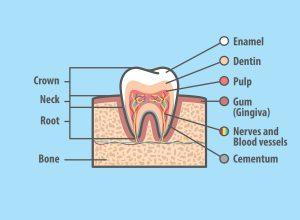Have you ever wondered what your teeth are made of? Knowing basic dental anatomy can benefit you and your dental health. The roots of their teeth extend below the gumline and make up most of the tooth. Unlike dental implants, natural teeth are held into place with ligaments that provide some level of flexibility. The roots of your teeth are essential for stimulating new bone growth and can lead to deterioration of the jawline and facial features if you do not replace teeth as they go missing.

Distinctive Structures of the Tooth
Enamel - The enamel is the extremely durable external coating of each tooth, the hardest substance found in the human body. Despite its hardness, it can deteriorate from the acids created by bacteria in the mouth from poor health.
Crown - The crown is the part that is visible above the gum line. There are essentially five major types of crown classifications found in the human mouth, discussed in great detail in the following section.
Gumline - The gumline is where the teeth merge with the supporting pink or red tinted tissue that surrounds them.
Root - The root has tiny canals that transfer blood and minerals to the inner pulp chamber of the tooth. It makes up two-thirds of the actual tooth and is attached by ligaments to the jawbone.
Dentin - Dentin is a softer layer of tooth material that surrounds the pulp chamber of the tooth. It features millions of tiny tubes that lead directly into the pulp of the tooth. When your teeth rot through the enamel layer, it can be difficult to save them without using a root canal that kills the nerve.
Pulp Chamber- The pulp chamber contains the nerves and other connecting tissue which feeds the tooth a blood supply to remineralize from the inside. Although your teeth are able to remineralize, the process takes a long time and will not repair teeth that are decayed but simply retain the health of any enamel left in the overall tooth structure.
Distinctive Crown Types
There are five major crown types in the human body.
Incisors - These teeth have sharp cutting edges that overlap to cut into foods. The front of the human mouth features four on the top and four on the bottom.
Cuspids - These four teeth are pointy and ideal for tearing deep into foods. They are also called canines and the chief distinction between the mouths of omnivores (those who eat plants and meat) and herbivores (plant eaters). Carnivores (meat eaters) also have these teeth.
Pre-molars - These teeth have the features of helping us tear and crush foods. We have two on each side of the upper and lower jaws for a total of eight.
Molars - The molars have a flat surface with many small cusps (points) to grind food down into smaller particles. We typically have eight altogether.
Wisdom Teeth - Wisdom teeth are the molars that come in at the very end of our jaw. These teeth often become impacted and need to be removed because of evolutionary changes have caused there to be less room in our mouth for more teeth.
